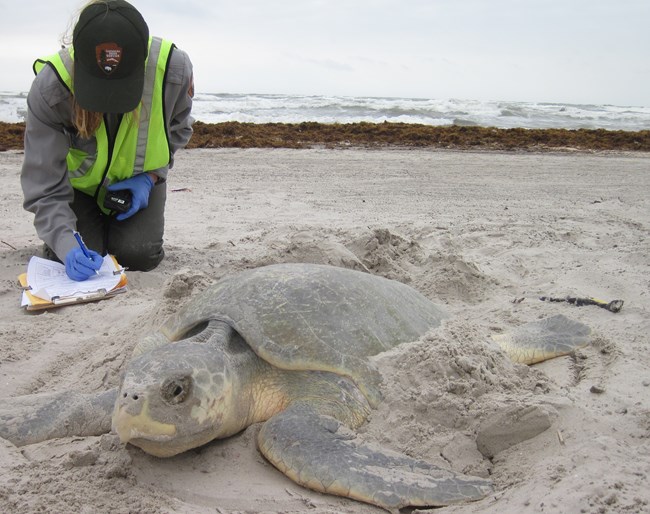
Successful conservation of sea turtles relies heavily on safeguarding the habitats they use throughout their lives. Kemp’s ridley sea turtles have been the focus of extraordinary conservation efforts since the 1960’s; they are the most endangered species of sea turtle in the world and multiple research projects have been dedicated to studying the behaviors and habitats of this species. With the help of satellite tracking, various projects have shed light on the importance of nearshore waters to adult Kemp’s ridleys in the Gulf of America. Nearshore waters are relatively shallow waters close to land and are among the most productive areas in the world. Protecting these waters is a crucial part of ongoing conservation efforts as they are vital to virtually every stage of Kemp’s ridleys lives. Satellite tracking has significantly improved the range of information available to highlight the importance of nearshore waters. Information collected from satellite tagged sea turtles has been studied to determine important migratory corridors, inter-nesting movements, post-nesting movements, and foraging sites and fidelity. The most frequently used waters during migration (outside of the nesting season) were an average of 20 meters deep and 26 km from the shore. Adults remain nearshore before, during, and after nesting. The inter-nesting period is the time between the first and last clutch of the season when females prepare to lay the next clutch of eggs, and protection of reproducing adults is essential during this time. Kemp’s ridleys have also shown fidelity (preference) to specific foraging sites in nearshore waters. Although the reasons for protecting food resources are apparent, these turtles can spend more than a year in a foraging site competing with shrimp and crab fisheries and, in some areas encountering declining prey. Since nearshore waters also produce a majority of the seafood we consume, the use of these waters by sea turtles increases potential impact from human activities. 
After drifting with currents for their first year of life, Kemp’s ridley sea turtles migrate to different areas to meet different requirements (mating, nesting, foraging, etc.), and remain within these waters throughout the remainder of their life history. This information emphasizes the importance of protecting nearshore waters throughout the year. While more research and work remains to be done, previous research has been essential to developing regulations to protect vital marine habitats within the nearshore waters in the Gulf of Mexico.
References: Shaver, D.J. & C. Rubio. 2008. Post-nesting movement of wild and head-started Kemp's ridley sea turtles Lepidochelys kempii in the Gulf of Mexico. Endangered Species Research 4:43-55. Shaver, D.J., K.M. Hart, I. Fujisaki, C. Rubio, A.R. Sartain, J. Peña, P.M. Burchfield, D. Gomez Gamez, & J. Ortiz. 2013. Foraging area fidelity for Kemp's ridleys in the Gulf of Mexico. Ecology and Evolution 3:2002-2012. Shaver, D.J., K.M. Hart, I. Fujisaki, C. Rubio, A.R. Sartain-Iverson, J. Peña, D. Gomez Gamez, R. de Jesus Gonzales Diaz Miron, P.M. Burchfield, H.J. Martinez, & J. Ortiz. 2015. Migratory corridor of adult female Kemp’s ridley turtles in the Gulf of Mexico. Biological Conservation 194:158-167. Shaver, D.J., K.M. Hart, I. Fujisaki, D. Bucklin, A.R. Iverson, C. Rubio, T.F. Backof, P.M. Burchfield, R. de Jesus Gonzales Diaz Miron, P.H. Dutton, A. Frey, J. Peña, D. Gomez Gamez, H.J. Martinez, & J. Ortiz. 2017. Inter-nesting movements and habitat-use of adult females Kemp’s ridley turtles in the Gulf of Mexico. PLOS ONE 12: e0174248. |
Last updated: February 18, 2025
